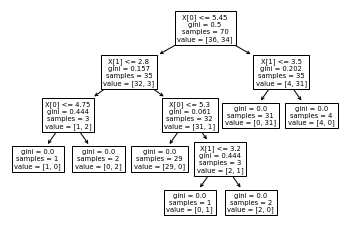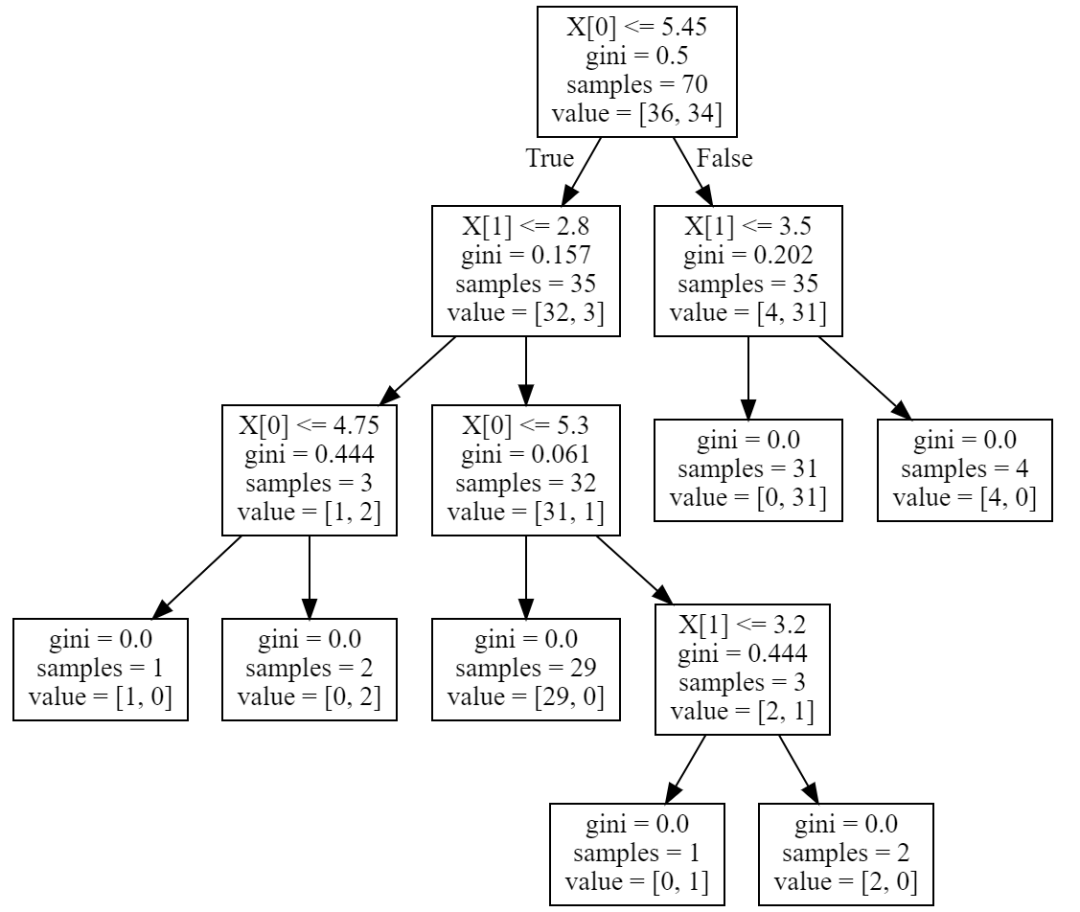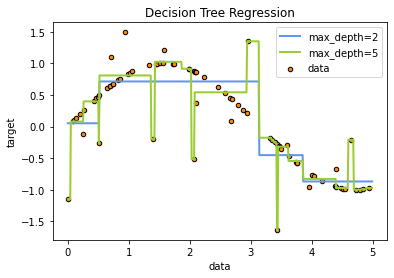【机器学习】决策树代码练习
本课程是中国大学慕课《机器学习》的“决策树”章节的课后代码。
课程地址:
https://www.icourse163.org/course/WZU-1464096179
课程完整代码:
https://github.com/fengdu78/WZU-machine-learning-course
代码修改并注释:黄海广,haiguang2000@wzu.edu.cn
机器学习练习7 决策树
代码修改并注释:黄海广,haiguang2000@wzu.edu.cn
1.分类决策树模型是表示基于特征对实例进行分类的树形结构。决策树可以转换成一个if-then规则的集合,也可以看作是定义在特征空间划分上的类的条件概率分布。
2.决策树学习旨在构建一个与训练数据拟合很好,并且复杂度小的决策树。因为从可能的决策树中直接选取最优决策树是NP完全问题。现实中采用启发式方法学习次优的决策树。
决策树学习算法包括3部分:特征选择、树的生成和树的剪枝。常用的算法有ID3、 C4.5和CART。
3.特征选择的目的在于选取对训练数据能够分类的特征。特征选择的关键是其准则。常用的准则如下:
(1)样本集合对特征的信息增益(ID3)
其中,是数据集的熵,是数据集的熵,是数据集对特征的条件熵。是中特征取第个值的样本子集,是中属于第类的样本子集。是特征取 值的个数,是类的个数。
(2)样本集合对特征的信息增益比(C4.5)
其中,是信息增益,是数据集的熵。
(3)样本集合的基尼指数(CART)
特征条件下集合的基尼指数:
4.决策树的生成。通常使用信息增益最大、信息增益比最大或基尼指数最小作为特征选择的准则。决策树的生成往往通过计算信息增益或其他指标,从根结点开始,递归地产生决策树。这相当于用信息增益或其他准则不断地选取局部最优的特征,或将训练集分割为能够基本正确分类的子集。
5.决策树的剪枝。由于生成的决策树存在过拟合问题,需要对它进行剪枝,以简化学到的决策树。决策树的剪枝,往往从已生成的树上剪掉一些叶结点或叶结点以上的子树,并将其父结点或根结点作为新的叶结点,从而简化生成的决策树。
import numpy as np
import pandas as pd
import math
from math import log
创建数据
def create_data():
datasets = [['青年', '否', '否', '一般', '否'],
['青年', '否', '否', '好', '否'],
['青年', '是', '否', '好', '是'],
['青年', '是', '是', '一般', '是'],
['青年', '否', '否', '一般', '否'],
['中年', '否', '否', '一般', '否'],
['中年', '否', '否', '好', '否'],
['中年', '是', '是', '好', '是'],
['中年', '否', '是', '非常好', '是'],
['中年', '否', '是', '非常好', '是'],
['老年', '否', '是', '非常好', '是'],
['老年', '否', '是', '好', '是'],
['老年', '是', '否', '好', '是'],
['老年', '是', '否', '非常好', '是'],
['老年', '否', '否', '一般', '否'],
]
labels = [u'年龄', u'有工作', u'有自己的房子', u'信贷情况', u'类别']
# 返回数据集和每个维度的名称
return datasets, labels
datasets, labels = create_data()
train_data = pd.DataFrame(datasets, columns=labels)
train_data
| 年龄 | 有工作 | 有自己的房子 | 信贷情况 | 类别 | |
|---|---|---|---|---|---|
| 0 | 青年 | 否 | 否 | 一般 | 否 |
| 1 | 青年 | 否 | 否 | 好 | 否 |
| 2 | 青年 | 是 | 否 | 好 | 是 |
| 3 | 青年 | 是 | 是 | 一般 | 是 |
| 4 | 青年 | 否 | 否 | 一般 | 否 |
| 5 | 中年 | 否 | 否 | 一般 | 否 |
| 6 | 中年 | 否 | 否 | 好 | 否 |
| 7 | 中年 | 是 | 是 | 好 | 是 |
| 8 | 中年 | 否 | 是 | 非常好 | 是 |
| 9 | 中年 | 否 | 是 | 非常好 | 是 |
| 10 | 老年 | 否 | 是 | 非常好 | 是 |
| 11 | 老年 | 否 | 是 | 好 | 是 |
| 12 | 老年 | 是 | 否 | 好 | 是 |
| 13 | 老年 | 是 | 否 | 非常好 | 是 |
| 14 | 老年 | 否 | 否 | 一般 | 否 |
熵
def calc_ent(datasets):
data_length = len(datasets)
label_count = {}
for i in range(data_length):
label = datasets[i][-1]
if label not in label_count:
label_count[label] = 0
label_count[label] += 1
ent = -sum([(p / data_length) * log(p / data_length, 2)
for p in label_count.values()])
return ent
条件熵
def cond_ent(datasets, axis=0):
data_length = len(datasets)
feature_sets = {}
for i in range(data_length):
feature = datasets[i][axis]
if feature not in feature_sets:
feature_sets[feature] = []
feature_sets[feature].append(datasets[i])
cond_ent = sum([(len(p) / data_length) * calc_ent(p)
for p in feature_sets.values()])
return cond_ent
calc_ent(datasets)
0.9709505944546686
信息增益
def info_gain(ent, cond_ent):
return ent - cond_ent
def info_gain_train(datasets):
count = len(datasets[0]) - 1
ent = calc_ent(datasets)
best_feature = []
for c in range(count):
c_info_gain = info_gain(ent, cond_ent(datasets, axis=c))
best_feature.append((c, c_info_gain))
print('特征({}) 的信息增益为: {:.3f}'.format(labels[c], c_info_gain))
# 比较大小
best_ = max(best_feature, key=lambda x: x[-1])
return '特征({})的信息增益最大,选择为根节点特征'.format(labels[best_[0]])
info_gain_train(np.array(datasets))
特征(年龄) 的信息增益为:0.083
特征(有工作) 的信息增益为:0.324
特征(有自己的房子) 的信息增益为:0.420
特征(信贷情况) 的信息增益为:0.363
'特征(有自己的房子)的信息增益最大,选择为根节点特征'
利用ID3算法生成决策树
# 定义节点类 二叉树
class Node:
def __init__(self, root=True, label=None, feature_name=None, feature=None):
self.root = root
self.label = label
self.feature_name = feature_name
self.feature = feature
self.tree = {}
self.result = {
'label:': self.label,
'feature': self.feature,
'tree': self.tree
}
def __repr__(self):
return '{}'.format(self.result)
def add_node(self, val, node):
self.tree[val] = node
def predict(self, features):
if self.root is True:
return self.label
return self.tree[features[self.feature]].predict(features)
class DTree:
def __init__(self, epsilon=0.1):
self.epsilon = epsilon
self._tree = {}
# 熵
@staticmethod
def calc_ent(datasets):
data_length = len(datasets)
label_count = {}
for i in range(data_length):
label = datasets[i][-1]
if label not in label_count:
label_count[label] = 0
label_count[label] += 1
ent = -sum([(p / data_length) * log(p / data_length, 2)
for p in label_count.values()])
return ent
# 经验条件熵
def cond_ent(self, datasets, axis=0):
data_length = len(datasets)
feature_sets = {}
for i in range(data_length):
feature = datasets[i][axis]
if feature not in feature_sets:
feature_sets[feature] = []
feature_sets[feature].append(datasets[i])
cond_ent = sum([(len(p) / data_length) * self.calc_ent(p)
for p in feature_sets.values()])
return cond_ent
# 信息增益
@staticmethod
def info_gain(ent, cond_ent):
return ent - cond_ent
def info_gain_train(self, datasets):
count = len(datasets[0]) - 1
ent = self.calc_ent(datasets)
best_feature = []
for c in range(count):
c_info_gain = self.info_gain(ent, self.cond_ent(datasets, axis=c))
best_feature.append((c, c_info_gain))
# 比较大小
best_ = max(best_feature, key=lambda x: x[-1])
return best_
def train(self, train_data):
"""
input:数据集D(DataFrame格式),特征集A,阈值eta
output:决策树T
"""
_, y_train, features = train_data.iloc[:, :
-1], train_data.iloc[:,
-1], train_data.columns[:
-1]
# 1,若D中实例属于同一类Ck,则T为单节点树,并将类Ck作为结点的类标记,返回T
if len(y_train.value_counts()) == 1:
return Node(root=True, label=y_train.iloc[0])
# 2, 若A为空,则T为单节点树,将D中实例树最大的类Ck作为该节点的类标记,返回T
if len(features) == 0:
return Node(
root=True,
label=y_train.value_counts().sort_values(
ascending=False).index[0])
# 3,计算最大信息增益 同5.1,Ag为信息增益最大的特征
max_feature, max_info_gain = self.info_gain_train(np.array(train_data))
max_feature_name = features[max_feature]
# 4,Ag的信息增益小于阈值eta,则置T为单节点树,并将D中是实例数最大的类Ck作为该节点的类标记,返回T
if max_info_gain < self.epsilon:
return Node(
root=True,
label=y_train.value_counts().sort_values(
ascending=False).index[0])
# 5,构建Ag子集
node_tree = Node(
root=False, feature_name=max_feature_name, feature=max_feature)
feature_list = train_data[max_feature_name].value_counts().index
for f in feature_list:
sub_train_df = train_data.loc[train_data[max_feature_name] ==
f].drop([max_feature_name], axis=1)
# 6, 递归生成树
sub_tree = self.train(sub_train_df)
node_tree.add_node(f, sub_tree)
# pprint.pprint(node_tree.tree)
return node_tree
def fit(self, train_data):
self._tree = self.train(train_data)
return self._tree
def predict(self, X_test):
return self._tree.predict(X_test)
datasets, labels = create_data()
data_df = pd.DataFrame(datasets, columns=labels)
dt = DTree()
tree = dt.fit(data_df)
tree
{'label:': None, 'feature': 2, 'tree': {'否': {'label:': None, 'feature': 1, 'tree': {'否': {'label:': '否', 'feature': None, 'tree': {}}, '是': {'label:': '是', 'feature': None, 'tree': {}}}}, '是': {'label:': '是', 'feature': None, 'tree': {}}}}
dt.predict(['老年', '否', '否', '一般'])
'否'
Scikit-learn实例
from sklearn.datasets import load_iris
from sklearn.model_selection import train_test_split
from collections import Counter
使用Iris数据集,我们可以构建如下树:
# data
def create_data():
iris = load_iris()
df = pd.DataFrame(iris.data, columns=iris.feature_names)
df['label'] = iris.target
df.columns = [
'sepal length', 'sepal width', 'petal length', 'petal width', 'label'
]
data = np.array(df.iloc[:100, [0, 1, -1]])
# print(data)
return data[:, :2], data[:, -1],iris.feature_names[0:2]
X, y,feature_name= create_data()
X_train, X_test, y_train, y_test = train_test_split(X, y, test_size=0.3)
决策树分类
from sklearn.tree import DecisionTreeClassifier
from sklearn.tree import export_graphviz
import graphviz
from sklearn import tree
clf = DecisionTreeClassifier()
clf.fit(X_train, y_train,)
clf.score(X_test, y_test)
0.9666666666666667
一旦经过训练,就可以用 plot_tree函数绘制树:
tree.plot_tree(clf)
[Text(197.83636363636364, 195.696, 'X[0] <= 5.45\ngini = 0.5\nsamples = 70\nvalue = [36, 34]'),
Text(121.74545454545455, 152.208, 'X[1] <= 2.8\ngini = 0.157\nsamples = 35\nvalue = [32, 3]'),
Text(60.872727272727275, 108.72, 'X[0] <= 4.75\ngini = 0.444\nsamples = 3\nvalue = [1, 2]'),
Text(30.436363636363637, 65.232, 'gini = 0.0\nsamples = 1\nvalue = [1, 0]'),
Text(91.30909090909091, 65.232, 'gini = 0.0\nsamples = 2\nvalue = [0, 2]'),
Text(182.61818181818182, 108.72, 'X[0] <= 5.3\ngini = 0.061\nsamples = 32\nvalue = [31, 1]'),
Text(152.1818181818182, 65.232, 'gini = 0.0\nsamples = 29\nvalue = [29, 0]'),
Text(213.05454545454546, 65.232, 'X[1] <= 3.2\ngini = 0.444\nsamples = 3\nvalue = [2, 1]'),
Text(182.61818181818182, 21.744, 'gini = 0.0\nsamples = 1\nvalue = [0, 1]'),
Text(243.4909090909091, 21.744, 'gini = 0.0\nsamples = 2\nvalue = [2, 0]'),
Text(273.92727272727274, 152.208, 'X[1] <= 3.5\ngini = 0.202\nsamples = 35\nvalue = [4, 31]'),
Text(243.4909090909091, 108.72, 'gini = 0.0\nsamples = 31\nvalue = [0, 31]'),
Text(304.3636363636364, 108.72, 'gini = 0.0\nsamples = 4\nvalue = [4, 0]')]

也可以导出树
tree_pic = export_graphviz(clf, out_file="mytree.pdf")
with open('mytree.pdf') as f:
dot_graph = f.read()
graphviz.Source(dot_graph)

或者,还可以使用函数 export_text以文本格式导出树。此方法不需要安装外部库,而且更紧凑:
from sklearn.tree import export_text
r = export_text(clf,feature_name)
print(r)
|--- sepal width (cm) <= 3.15
| |--- sepal length (cm) <= 4.95
| | |--- sepal width (cm) <= 2.65
| | | |--- class: 1.0
| | |--- sepal width (cm) > 2.65
| | | |--- class: 0.0
| |--- sepal length (cm) > 4.95
| | |--- class: 1.0
|--- sepal width (cm) > 3.15
| |--- sepal length (cm) <= 5.85
| | |--- class: 0.0
| |--- sepal length (cm) > 5.85
| | |--- class: 1.0
决策树回归
import numpy as np
from sklearn.tree import DecisionTreeRegressor
import matplotlib.pyplot as plt
# Create a random dataset
rng = np.random.RandomState(1)
X = np.sort(5 * rng.rand(80, 1), axis=0)
y = np.sin(X).ravel()
y[::5] += 3 * (0.5 - rng.rand(16))
# Fit regression model
regr_1 = DecisionTreeRegressor(max_depth=2)
regr_2 = DecisionTreeRegressor(max_depth=5)
regr_1.fit(X, y)
regr_2.fit(X, y)
# Predict
X_test = np.arange(0.0, 5.0, 0.01)[:, np.newaxis]
y_1 = regr_1.predict(X_test)
y_2 = regr_2.predict(X_test)
# Plot the results
plt.figure()
plt.scatter(X, y, s=20, edgecolor="black", c="darkorange", label="data")
plt.plot(X_test, y_1, color="cornflowerblue", label="max_depth=2", linewidth=2)
plt.plot(X_test, y_2, color="yellowgreen", label="max_depth=5", linewidth=2)
plt.xlabel("data")
plt.ylabel("target")
plt.title("Decision Tree Regression")
plt.legend()
plt.show()

决策树调参
# 导入库
from sklearn.tree import DecisionTreeClassifier
from sklearn import datasets
from sklearn.model_selection import train_test_split
import matplotlib.pyplot as plt
from sklearn.model_selection import GridSearchCV
from sklearn.tree import DecisionTreeRegressor
from sklearn import metrics
# 导入数据集
X = datasets.load_iris() # 以全部字典形式返回,有data,target,target_names三个键
data = X.data
target = X.target
name = X.target_names
x, y = datasets.load_iris(return_X_y=True) # 能一次性取前2个
print(x.shape, y.shape)
(150, 4) (150,)
# 数据分为训练集和测试集
x_train, x_test, y_train, y_test = train_test_split(x,
y,
test_size=0.2,
random_state=100)
# 用GridSearchCV寻找最优参数(字典)
param = {
'criterion': ['gini'],
'max_depth': [30, 50, 60, 100],
'min_samples_leaf': [2, 3, 5, 10],
'min_impurity_decrease': [0.1, 0.2, 0.5]
}
grid = GridSearchCV(DecisionTreeClassifier(), param_grid=param, cv=6)
grid.fit(x_train, y_train)
print('最优分类器:', grid.best_params_, '最优分数:', grid.best_score_) # 得到最优的参数和分值
最优分类器: {'criterion': 'gini', 'max_depth': 30, 'min_impurity_decrease': 0.2, 'min_samples_leaf': 3} 最优分数: 0.9416666666666665
参考
https://github.com/fengdu78/lihang-code
《统计学习方法》,清华大学出版社,李航著,2019年出版
https://scikit-learn.org
